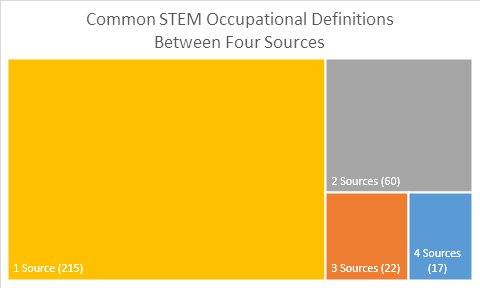The media often reports that STEM (Science, Technology, Engineering, and Mathematics) jobs are in-demand. They have been growing, are expected to continue growing, and generally pay a good wage. But when it comes to the occupations that should count as“STEM jobs,” there is far less agreement.
Forecasts and reports of STEM growth are often cited in the media, but different definitions make comparisons between studies extremely difficult, if not impossible. To explore this problem, we compared four often-used definitions of STEM occupations:
- A widely cited study from the Department of Commerce Economics and Statistics Administration;
- The Occupational Information Network O*NET OnLine sponsored by the Department of Labor;
- The National Science Foundation Science and Engineering Indicators 2014; and
- The SOC Policy Committee recommendation.
Among the different definitions, 314 unique occupation titles were identified as STEM. Those 314 titles represent over a third of the 840 detailed Standard Occupational Classification (SOC) codes.[1]
The Department of Commerce study had the narrowest definition, with 54 occupations. The SOC Policy Committee recommended 184 STEM occupation codes and was the only definition to include healthcare occupations (64 health occupations).

Only 17 titles were included in all four definitions of STEM occupations. About half of these 17 occupations are engineers, while another 4 are related to computer science. Math is represented by mathematicians and statisticians, while science is limited to astronomers, atmospheric and space scientists, and natural sciences managers.
Based on the 4 STEM definitions reviewed here, the following 17 occupations should be included in any analysis of STEM jobs, though they are clearly not comprehensive (the complete list is shown in alphabetical order):
| Aerospace Engineers | Computer Programmers |
| Agricultural Engineers | Database Administrators |
| Astronomers | Environmental Engineers |
| Atmospheric and Space Scientists | Mathematicians |
| Biomedical Engineers | Mechanical Engineers |
| Chemical Engineers | Natural Sciences Managers |
| Computer and Information Systems Managers | Nuclear Engineers |
| Computer Hardware Engineers | Petroleum Engineers |
| Statisticians | |
| Source: Chmura Economics & Analytics | |
Similarly, 22 occupations were included in three definitions. Often in this category, the incongruence between sources is due to SOC code changes over time and/or degree of detail in the occupation code chosen (the full list is presented in the table below in alphabetical order):
| Biochemists and Biophysicists
|
Marine Engineers and Naval Architects
|
| Biological Technicians
|
Materials Engineers
|
| Chemical Technicians
|
Materials Scientists
|
| Chemists
|
Mining and Geological Engineers, Including Mining Safety Engineers
|
| Civil Engineers
|
Network and Computer Systems Administrators
|
| Computer and Information Research Scientists
|
Operations Research Analysts
|
| Computer Network Architects
|
Physicists
|
| Electrical Engineers
|
Sales Engineers
|
| Electronics Engineers, Except Computer
|
Software Developers, Applications
|
| Industrial Engineers
|
Software Developers, Systems Software
|
| Information Security Analysts
|
Surveying and Mapping Technicians
|
| Source: Chmura Economics & Analytics
|
Although the definition of STEM is somewhat dependent on how the information is used, there is some common ground in defining STEM occupations. Thirty-nine detailed occupation codes match across at least three sources, and 64 of the 215 codes with only one source can be explained by their relation to healthcare—usually differentiated in STEM-H definitions.
As we read and conduct studies about STEM jobs, these common occupations should be kept in mind as the types of jobs typically considered “STEM.”
The full list of occupations and number of sources is show here: STEM Occupations.
Research support provided by Patrick Clapp.
[1] Some of the occupations are from older SOC definitions, cross two or more codes, or are otherwise not included in the standard detailed codes (hence much of the problem with pinning down a definition).
.png)